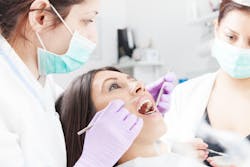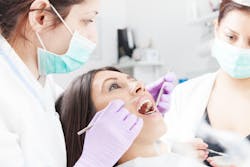Hygiene department efficiency
By Dianne Glasscoe Watterson, MBA
Dear Dianne,
My practice is about 80% PPO. One thing that I've seen over the years is that reimbursement for procedures has not risen nearly as quickly as costs. My hygienists do not understand why I can't give them substantial raises, although they feel they deserve to continue to receive annual raises. I've been considering different ways to increase the efficiency in my hygiene department, such as reducing the amount of time per patient, or even assisted hygiene. Any thoughts? – Dr. Will
Dear Dr. Will,
Let me pose a question: How productive would you be if you had to do everything by yourself? If you didn't have a qualified assistant to help you, your productivity would take a nosedive. By the same token, hygienists can increase their productivity substantially with an assisted model. If your hygienists are accustomed to scheduling one patient per hour, that would amount to seven to eight patients per day. With an assistant, the hygienist can easily increase to 12 to 13 patients per eight-hour day.
There are some prerequisites that must be met before you can implement the assisted model. First, you must have two operatories available that are fully equipped for hygiene use, including power scalers in both rooms. Second, you must have an assistant that is dedicated to helping the hygienist. (The assistant can't be expected to assist you and the hygienist.) Third, your business desk must be trained in how to properly engineer an assisted day. If you have these prerequisites in place, then you are ready to implement the model.
The advantages of assisted hygiene are many, but the most important is that the hygienist is being used to his or her greatest capability. The hygienist is able to provide more chairside service and is not using valuable time performing nonproductive functions, such as room turnover, sterilization, dismissing, and reappointment of patients. The upside for the hygienist is that he or she always has help performing the all-important periodontal chartings.
Another great advantage is that the hygienist never has to waste time waiting for you to come in and do the hygiene exam. He or she can move on to the next patient, while the assistant waits with the patient and assists with the exam where needed. Your hygienists will be less tired at day's end, because stress is reduced by not fighting the clock all day.
The assisted model allows the hygienist to see more patients, and that increases productivity. Even if you are only able to increase by two additional patients per day, the increase to production will be substantial over time. Do the math.
Here is a conservative example. If you increase productivity by $300 per day, that comes to $1,200 per week, and $60,000 per year at 50 weeks. At $12 per hour for an entry-level assistant, that's $96 per day, $384 per week, and $19,200 per year. Your profit will be approximately $40,000. Many offices that implement assisted hygiene see increases in the hygiene department productivity by 30% to 50%.
Of course, your hygienists need to be on board with this. The concept needs to be introduced with an emphasis on the advantages for the hygienist. And please do not make the mistake of calling the assisted model of hygiene "accelerated" hygiene. This is likely to conjure up unpleasant images of running around like one's lab coat is on fire. The assisted model is not meant to accelerate anything. What it is designed to do is shift duties to a qualified assistant and take that burden off the hygienist.
I believe that now more than ever, we have to find more efficient ways to provide care. Assisted hygiene is a great way to increase efficiency and productivity in the hygiene department. If you would like a complimentary copy of a sample assisted schedule, please email me.
All the best,
Dianne
_________________________________
More from Dianne Glasscoe Watterson, MBA:
- 6 communication tips to improve customer service in your dental practice
- Time dilemma
- Tardy dental patients: Better late than never?
_________________________________
Dianne Glasscoe Watterson, MBA, is a consultant, speaker, and author. She helps good practices become better through practical on-site consulting. Her book, "Manage Your Practice Well," is available at professionaldentalmgmt.com. For consulting or speaking inquiries, contact Dianne at [email protected] or call her at (301) 874-5240.
Past DE Articles


